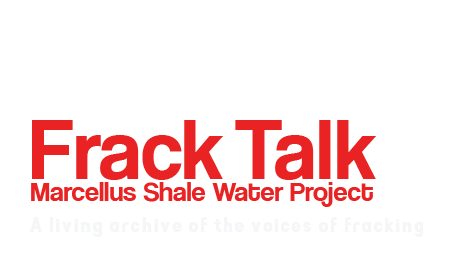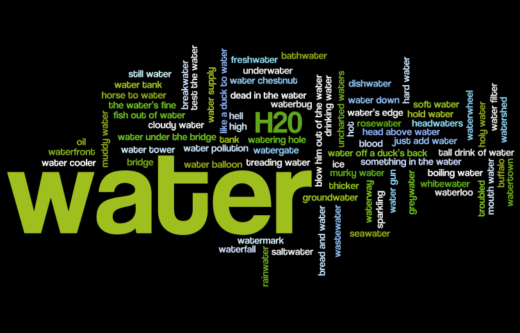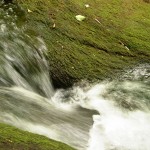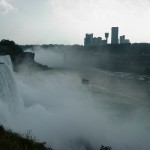Body. Earth. Water.
What moves through us and around us.
The Marcellus Shale Formation
Why is water important?
Water composes the majority of the earth and of our bodies. But how often do we consider the role of water in our life? Can we assume we will always have access to it? A major component of the natural gas debate is the abundant use of fresh water in the hydro-fracturing (fracking) process. Each well requires approximately 3 to5 million gallons of fresh water.
- What was the closest body of water to you when you were growing up?
- What’s the farthest distance you’ve traveled to a body of water?
- Do you prefer a bath or a shower?
- Where do you like to swim?
- Would you rather live near the mountains, the ocean, or a lake?
- How much water do you drink?
- What does water mean to you?
- How do you use water differently than your grandparents?
Why is water important, anyway? Read about it below and let us know what you think by joining the conversation.
The Meeting of the Waters by Thomas Moore
There is not in the wide world a valley so sweet
As that vale in whose bosom the bright waters meet;
Oh! the last rays of feeling and life must depart,
Ere the bloom of that valley shall fade from my heart.
Yet it was not that nature had shed o’er the scene
Her purest of crystal and brightest of green;
‘Twas not her soft magic of streamlet or hill,
Oh! no, – it was something more exquisite still.
‘Twas that friends, the beloved of my bosom, were near,
Who made every dear scene of enchantment more dear,
And who felt how the best charms of nature improve,
When we see them reflected from looks that we love.
Sweet vale of Avoca! how calm could I rest
In thy bosom of shade, with the friends I love best,
Where the storms that we feel in this cold world should cease,
And our hearts, like thy waters, be mingled in peace.
WATER ON EARTH
- Water covers 70.9% of the Earth’s surface.
- The earth’s supply of fresh water is limited. Salt water makes up 97% of all water on earth. The energy needed to convert salt water to fresh water is considered too great to use the oceans as a source of fresh water.
- Water exists in three states on earth: liquid, solid, gas
- Approximately 70% of freshwater is used by agriculture.
- The boiling point of water (and all other liquids) is dependent on the barometric pressure. For example, on top of Mt. Everest water boils at 68 °C (154 °F), compared to 100 °C (212 °F) at sea level.
- Sea water contains about 3.5% salt.
- Water moves perpetually through each of these processes in the water cycle:
- Evaporation from oceans and other water bodies into the air and transpiration from land plants and animals into air.
- Precipitation from water vapor condensing from the air and falling to earth or ocean.
- Runoff of water moving across the land, often reaching the sea
- Condensation from water vapor into liquid, forming clouds and fog.
- Most water vapor over the oceans returns to the oceans, but winds carry water vapor over land at the same rate as runoff into the sea (and then the evaporation and precipitation over land)
- An aquifer is an underground layer of permeable rock or other materials (gravel, sand, silt, or clay) allowing the flow of water. Wells extract groundwater from aquifers.
- Most areas on earth have some sort of aquifer beneath the surface. Aquifers may occur at various depths. Those closer to the surface provide easier access to the water and allow rainfall to reenter the earth.
- Wells are built to provide access to underground aquifers.
WATER IN THE BODY
- The human body contains anywhere from 55% to 78% water depending on body size.
- It is regularly suggested that humans should drink 8 glasses of water a day.
GLOBAL WATER ACCESS
- Civilization has historically flourished around rivers and major waterways.
- 40% of the world’s inhabitants currently have insufficient fresh water for minimal hygiene.
- More than 2.2 million people died in 2000 from waterborne diseases (related to the consumption of contaminated water) or drought.
- World Water Day is one of the international days declared by the UN, on 22 March, as declared by the UN General Assembly in 1992.
- The water table levels are falling in scores of countries (including China, the US, and India) due to widespread overpumping. As water grows scarcer, so does grain production, driving up the cost of our most basic food source.
- In 2006, waterborne diseases were estimated to cause 1.8 million deaths each year while about 1.1 billion people lacked proper drinking water. Sewage is the leading cause of water contamination.
- Not every nation can afford to treat and transport water to all people. 2003 statistics from El Salvador, for instance, indicate that the poorest 20% of households spend more than 10% of their total income on water.
- In the U.S, the typical single family home uses 69.3 gallons of water per person per day.
- 1.6 million people die every year from diseases attributable to lack of access to safe drinking water and basic sanitation (including cholera, typhoid fever, dysentery, trachoma, plague and typhus). 90% of these are children under 5, mostly in developing countries;
- Water scarcity affects one in three people on every continent of the globe.
- Almost one fifth of the world’s population (about 1.2 billion people) live in areas where the water is physically scarce. One quarter of the global population also live in developing countries that face water shortages due to a lack of infrastructure to retrieve water from rivers and aquifers.
- Freshwater scarcity has increased the use of wastewater for agricultural purposes in poor urban and rural communities. More than 10% of people worldwide consume foods irrigated by wastewater that can contain chemicals or disease-causing organisms.
- In Africa, people (mostly women) spend 40 billion hours every year walking for water. Their closest source of water is often unclean and located miles away.
- Rural women walk an average of four miles to fetch water.
WATER IN THE USA
- In the US, wastewater generated by humans may be referred to as greywater, which is treatable and able to be made potable again, and blackwater, which generally contains sewage and other forms of waste which is much more difficult to make resuable.
- In the US, 30% of freshwater use is for irrigation
- Water Industry: gathering and distributing clean water and removing wastewater
- Drinking water can come from natural springs, manmade wells, lakes, or rainwater.
- Spring water comes from a spring where water meets the ground level. A well involves water pumped to the surface from below the ground.
- Freshwater from the earth may still need to be purified. Popular methods are filtering with sand which only removes solid materials, while chlorination and boiling kill harmful microbes. Distillation does all three functions.
- The Colorado river’s headwaters are in Colorado, it created and flows through the Grand Canyon, is damned at several places to create reservoirs of usable water (Hoover Dam), and it flows out into the Gulf of California. Due to irrigation diversions, the river sometimes goes dry before reaching the Gulf.
- The Colorado River provides power to 3 million homes, waters 15% of our agriculture in the West, and gives one in 12 people something to drink.
- Hydropower uses water to drive a turbine connected to a generator to create power.
WATER IN NEW YORK STATE
- New York state is divided into 17 watersheds, or drainage basins.
- The Delaware River Watershed (12,800 square miles) covers parts of New York, Pennsylvania, New Jersey and Delaware. The Delaware river originates in the Catskill Mountains and eventually flows into the Delaware Bay and the Atlantic Ocean.
- The Delaware River Watershed includes 4,062 miles of freshwater rivers and streams.
- The Delaware River Watershed includes 88 significant freshwater lakes, ponds, and reservoirs (covering 24,932 acres), including:
- Pepacton Reservoir (5,185 lake/reservoir acres)
- Cannonsville Reservoir (4,605 acres)
- Neversink Reservoir (1,469 acres)
- Most of the concern for the water quality in the Delaware River Watershed revolves around protecting the reservoirs functions as providers of freshwater for New York City.
- The Ashokan Reservoir is NY City’s deepest reservoir and can hold 122.9 billion gallons of water.
- New York City is supplied by three reservoir systems:
The Croton System
Containing 12 reservoirs and five lakes, covering about 370 square miles of the Croton River Drainage Basin. The average yield of the system is 300 million gallons per day.
The Catskill System
The Ashokan and the Schoharie make up the two reservoirs in the Catskill System. The Ashokan Reservoir collects water from 247 square miles of the drainage basin of the Esopus Creek which drains into the Hudson River. Water from the Ashokan Reservoir is fed into the Catskill Aqueduct and delivered to the Kensico reservoir or the Hillview Reservoir. The Schoharie Reservoir collects water from the 314 square mile drainage basin of the Schoharie Creek which drains into the Mohawk River. Water from the Schoharie Reservoir is delivered to the Esopus Creek Basin via the Shandanken Tunnel which drains into a branch of the Esopus Creek and thence by open stream to the Ashokan Reservoir.
The Delaware System
The Delaware System consists of three reservoirs located in the Delaware River Basin, the Canonsville, Pepacton and Neversink Reservoirs, and the Rondout Reservoir on Rondout Creek in the Hudson River Basin. Water is delivered via separate tunnels from Cannonsville, Pepacton and Neversink Reservoirs to Rondout Reservoir and from there through the Delaware Aquduct to the Kensico Reservoir. The Delaware Aqueduct intercepts the Croton System at the West Branch Reservoir. The Cannonsville Reservoir receives water from the 450 square mile watershed of the West Branch of the Delaware River. The Pepacton Reservoir receives water from the 372 square mile watershed of the East Branch of the Delaware River. The Neversink Reservoir receives water from the 93 square mile watershed of the Neversink River. The Rondout Reservoir receives water from the 95 square mile watershed of the Rondout River and serves as a collecting reservoir for the water from the three other reservoirs in the Delaware system. Water from the Rondout Reservoir travels through the Delaware Aqueduct to the West Branch Reservoir in the Croton System. Water from the Pepacton and Neversink Tunnels is also used to produce hydroelectricity.
WATER IN CULTURE
- Water serves as a ritual purifier in most religions (ie. baptism)
- In Sri Lanka, water is seen to aid fertility and is used ritualistically in marriage ceremonies.
- The Ancient Greek philosopher Empedocles named water as one of the four classical elements along with fire, earth and air.
- Water was also one of the five elements in traditional Chinese philosophy, along with earth, fire, wood, and metal.
- Many water gods exist in various mythologies:
Apam Napat (Hindu/Vedic), god of fresh water
Pariacaca, (Incan), god of water and rainstorms
Arnapkapfaaluk (Inuit), a fearsome sea goddess
Suijin, Shinto (Japanese), god of water
Tangaroa (Maori), god of the sea
Aegir (Norse/Germanic), personification of the sea
Neptune (Roman), king of the sea
Veles (Slavic), god of earth, waters, and the underworld
Yemaja,or Yemaya (Yoruba), goddess of the ocean
Poseidon (Greek), king of the sea and lord of the sea gods
Tethys (Greek), mother of the rivers, springs, streams, fountains and clouds
Earth-diver myths are common in Native American folklore, as well as other traditional creation myths. These stories often entail a supreme being sending an animal into the water to find sand or mud with which to build habitable land. The stories center around the idea of the land emerging from the water.
NATURAL GAS DRILLING
- Hydraulic Fracturing (frac’ing or fracking) is a process that creates fractures in the earth (such as shale or coal beds). In industry, this is used to stimulate oil and gas wells and increase accessibility. Holes are drilled into the rock, and fracking fluid is pumped through to fracture the rock. Proppant (made of sand, ceramic, or other particles) is inserted to prevent the fractures from closing.
- Hydraulic Fracturing in the New York City Watershed area would use between 3 and 8 million gallons of water, along with chemicals, to facilitate the fracturing process.
- Fluids may extend as far as 2000 feet from the bore hole of a direct vertical drill. Horizontal fracturing can extend the reach an additional 2000 feet.
- An estimated 30% to 70% of the fracking fluid resurfaces, exposing the toxic substances that are naturally present in underground oil and gas deposits, as well as the chemicals used in the fluid itself.
- Most drillings sites have pits for storing fracking fluids and the contaminated water (produced water) which surfaces with the gas. Produced water is found in most regions where gas is extracted and continues to surface for the life of the well (20 to 30 years).
- To extract natural gas, companies drill horizontal wells at coalbed methane basins to access the gas. According to the EPA, these basins are often located within sources of drinking water. The EPA determined that in some cases, hydraulic fracturing chemicals are injected directly into underground sources of drinking water during the course of normal fracturing operations.
- EPA cited a study conducted in six U.S. states, which found that in 50% of Coalbed Methane basins, the fracturing fluids moved out of the coals and into adjacent formations.
- Despite this, the EPA’s Evaluation of Impacts to Underground Sources of Drinking Water by Hydraulic Fracturing of Coalbed Methane Reservoirs concluded that hydraulic fracturing does not pose a threat to drinking water and human health and thus, it deemed it unnecessary to conduct further studies.
- Halliburton staff was actively involved in the review of the 2004 EPA report on hydraulic fracturing. Halliburton patented hydraulic fracturing in the 1940’s and remains one of the largest manufacturers of fracking fluid. Vice Presdent Dick Cheney, once the CEO of Halliburton, worked to get hydraulic fracturing exempt from the Safe Drinking Water Act. The oil and gas industry is the only industry allowed to inject dangerous substances into the ground without EPA regulation.
- A Marcellus well will use between 600,000 to 2,000,000 million gallons of water for a vertical well or 2,000,000 to 5,000,000 gallons for a horizontal well. Fluid is brought in on trucks (550 to 2,500 tanker truckloads of water).
- Most natural gas companies reveal the fracking fluid to be 98-99% water and sand. The other 2% is a mix of unspecified chemicals. However, if a single well uses 5 million gallons of fluid (using our valuable freshwater resources) 1.5 percent of the mixture would contain 75,000 gallons of chemicals in a single spot.
- The Safe Drinking Water Act (SDWA), originally passed in 1974, is the main federal law that ensures the quality of Americans’ drinking water
- If your drinking water comes from a private well, you are legally responsible for your water’s safety
- Groundwater flows downhill. If groundwater is contaminated near a gas well, the contamination could extend even farther with natural water flow.
- Groundwater is typically found about 10 feet to 200 feet below the ground surface.
- The Federal Energy Policy Act of 2005 specifically exempted hydraulic fracturing fluids from the Safe Drinking Water Act and other federal environmental laws.
- The exact chemicals included in fracking are kept not disclosed by oil, but they can include: butoxyethanol, Monoethanolamine, Ethylhexanol, Dazomet, Formaldehyde, Acetic Anhydride, Glutaraldehyde, Isopropanol, Boric Acid, Propargyl Alcohol (Prop-2-yn-1-01), Ethane-1,2-diol (ethylene glycol), 5-chloro-2-methyl-4-isothiazotin-3-one, Ethylene Glycol, Sodium Bicarbonate (NaHCO3), Methanol, and Diesel.
- Possible contaminants from fracking:
- Chemicals associated with drilling the well such as acids, used to help dissolve rock, salts, used to thicken drilling fluids, chemicals used to thicken drilling mud, and oil/grease from machinery
- Chemicals added to water to ease the fracturing process such as surfactants (detergents used to make water flow easier), biocides (used to kill microorganisms that can gum up the well hole)
- Chemicals that are often released from underground rock formations the well hole passes through, including the Marcellus Shale. This includes metals, e.g., barium, iron, manganese, calcium, arsenic, strontium, lead, cadmium, chromium, aluminum and others, naturally occurring radioactive materials (NORMs) such as uranium, radium, radon and others, methane, salty water from underground pockets
- Estimated cost to test your water for the above contaminants: $427
All Day I Hear the Noise of Waters by James Joyce
All day I hear the noise of waters
Making moan,
Sad as the sea-bird is when, going
Forth alone,
He hears the winds cry to the water’s
Monotone.
The grey winds, the cold winds are blowing
Where I go.
I hear the noise of many waters
Far below.
All day, all night, I hear them flowing
To and fro.
Going for Water by Robert Frost
The well was dry beside the door,
And so we went with pail and can
Across the fields behind the house
To seek the brook if still it ran;
Not loth to have excuse to go,
Because the autumn eve was fair
(Though chill), because the fields were ours,
And by the brook our woods were there.
We ran as if to meet the moon
That slowly dawned behind the trees,
The barren boughs without the leaves,
Without the birds, without the breeze.
But once within the wood, we paused
Like gnomes that hid us from the moon,
Ready to run to hiding new
With laughter when she found us soon.
Each laid on other a staying hand
To listen ere we dared to look,
And in the hush we joined to make
We heard, we knew we heard the brook.
A note as from a single place,
A slender tinkling fall that made
Now drops that floated on the pool
Like pearls, and now a silver blade.
Water, is taught by thirst by Emily Dickinson
Water, is taught by thirst.
Land – by the Oceans passed.
Transport – by throe –
Peace – by its battles told –
Love, by Memorial Mold –
Birds, by the Snow.
Sources and Links
http://www.toxicstargeting.com/ (map to search for toxins in your area)
http://waterandculture.org
http://wri.eas.cornell.edu/index.html
http://www.earthworksaction.org/publications.cfm?pubiD=402
http://www.eserc.stonybrook.edu/cen514/info/nyc/watersupply.html
http://www.riverreporter.com/issues/08-12-04/news-fracking.html
http://gaslandthemovie.com/whats-fracking
http://www.vanityfair.com/business/features/2010/06/fracking-in-pennsylvania-201006
http://www.earthworksaction.org/FracingDetails.cfm#FOOTNOTE6
http://www.frackcheckwv.net/impacts/
http://theintelligencer.net/page/content.detail/id/549992/What-s-In-The-Water—Fracking-Chemicals-Under-Microscope.html?nav=515
http://water.epa.gov/lawsregs/rulesregs/sdwa/index.cfm
http://water.epa.gov/drink/local/ny.cfm
http://wri.eas.cornell.edu/ag-water.html
http://www.earthworksaction.org/halliburton.cfm




